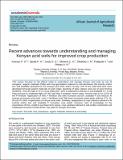| dc.contributor.author | Peter Kisinyo, Valerie Adema Palapala, Samuel Gudu, PA Opala, Caleb Othieno, JR Okalebo, AN Otinga | |
| dc.date.accessioned | 2020-08-12T07:20:25Z | |
| dc.date.available | 2020-08-12T07:20:25Z | |
| dc.date.issued | 2014-06-18 | |
| dc.identifier.uri | https://repository.maseno.ac.ke/handle/123456789/1996 | |
| dc.description.abstract | This review focused on the efforts made to understand and manage Kenyan acid soils by use of inorganic, organic materials (OMs) and crop germplasms tolerant to soil aluminium (Al) toxicity and/or low soil available phosphorus (P). Kenyan acid soils which occupy 13% of the total land area were developed through parent materials of acid origin, leaching of base cations and use of acid forming fertilizers. They are high in Al (> 2 cmol Al/kg and> 20% Al saturation) and low in soil available P (< 5 mg P/kg soil) due to moderate-high (107-402 mg P/kg) P sorption, hence crops recover only 9.6 to 13.5% of the P fertilizer. Application of lime, P fertilizer and OMs increases soil pH, available P and reduces Al toxicity on Kenyan acid soils. Lime, P fertilizers and OMs have increased maize grain yield by 5-75, 18-93 and 70-100%, respectively on Kenyan acid soils. Similarly, deployment of crop cultivars tolerant to Al toxicity … | en_US |
| dc.publisher | African Journal of Agricultural Reseach | en_US |
| dc.subject | Acid soils, Lime, phosphorus, organic materials, tolerance to soil acidity. | en_US |
| dc.title | Recent advances towards understanding and managing Kenyan acid soils for improved crop production | en_US |
| dc.type | Article | en_US |

